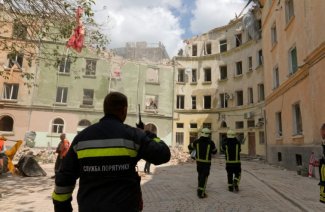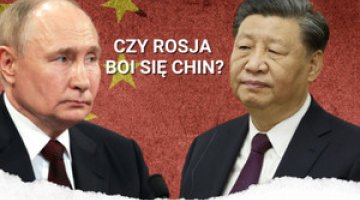Rocket attack on Lviv. Day 498 of the war

On 6 July, the Russians launched a rocket attack on Lviv and the surrounding region. One rocket hit a complex of buildings in the city centre; ten civilians were killed and 42 wounded. Thirty-five buildings were destroyed or damaged. Two more of the 10 Kalibr cruise missiles used in the attack were said to have hit Lviv (the Ukrainian Air Force Command claimed to have shot down seven of them). The city authorities reported that critical infrastructure had been hit, and according to the Ministry of Energy, a power line and three transformer substations were affected. Destruction was also reported in the Zolochiv region. On the same day, rockets also hit Kostiantynivka in Donetsk oblast and an unspecified industrial facility in Cherkasy oblast. On 5 July, Druzhkivka came under Russian missile attack, as did Pervomaiske and Bily Kolodyaz in Kharkiv oblast the day before. Meanwhile on 7 July, missiles fell on Avdiivka, Poltavka in Zaporizhzhia oblast, Horokhivske hromada in Mykolaiv oblast, and an unspecified location in Kherson oblast. The Russians used Kalibr, Iskander and S-300 missiles. On 7 July, Ukrainian Air Force Command spokesman Colonel Yuri Ihnat announced that the enemy was using an average of 100 missiles of various types per month in its attacks on Ukraine, including Kh-22 cruise missiles and missiles from S-300 systems (which are no longer in production).
On the night of 7 July, the Russians carried out an attack using 18 Shahed-136/131 kamikaze drones, 12 of which were shot down by the defenders. The others hit targets in the Dnipropetrovsk (including an enterprise near Kryvyi Rih) and Mykolaiv oblasts (Ochakiv). The use of Shahed drones by the invaders was also reported on 5 July; the Ukrainian Air Force Command reported that it had destroyed three of them. On 6 July, Russian artillery shelled Ochakiv four times and its surroundings five times. Outside the combat areas, the Russians also continued shelling and bombarding the right-bank part of Kherson oblast and the border areas of Sumy oblast. Ukrainian forces intensified their attacks on enemy infrastructure in Donetsk oblast using HIMARS systems and Storm Shadow cruise missiles. On 4 July they struck Donetsk and Makiivka (most likely an ammunition depot), on 5 July the railway junction at Yasynuvata and a fuel depot at Makiivka, and on 6 July Makiivka once again. The Russian side reported that civilians had been killed and wounded in Donetsk and Makiivka. On 5 July, the Ukrainians also attacked Berdiansk.
Ukrainian troops have resumed their assault on the north-western and south-western outskirts of Bakhmut, where particularly heavy clashes for control of the hills on the outskirts of Klishchiivka took place on 5 and 6 July. On 7 July, General Staff spokesman Andriy Kovalev enigmatically reported a partial success in the area of Klishchiivka, while Colonel Serhiy Cherevaty, the spokesman for the Eastern Grouping of the Armed Forces of Ukraine, stated that the defenders had advanced by more than a kilometre on both flanks of Bakhmut within the previous 24 hours. In the same period, the invaders broke through the Ukrainian defences in Luhansk oblast (south-east of Kupiansk) between Kuzemivka and Novoselivske, entering the latter village and partially outflanking it. However, their subsequent attacks west and south of Kreminna and north-west of Bakhmut, as well as in the area around Avdiivka and Marinka, failed to bring about any changes. The subsequent Ukrainian attacks south of Velyka Novosilka and south and west of Orikhiv were also unsuccessful. On 5 July, the deputy chief of the Main Operational Directorate of the General Staff of the Ukrainian army, General Oleksiy Hromov, summed up the situation in the south in these terms: since the beginning of the offensive, the defenders have liberated nine towns and an area of nearly 160 km2, and have advanced up to 7.5 km into areas previously controlled by the Russians.
On 5 July, General Hromov revealed that, according to information gained by Ukrainian intelligence, the enemy forces had created an extensive system of engineering barrages in the occupied territories, some elements of which range from 10 to 40 km in length. He pointed out that the line of contact between the belligerent troops in all directions now spans more than 1200 km. He pointed out that the terrain behind the front line is heavily mined, requiring the use of specialised equipment to enable the path to be cleared for advancing troops; to further enhance the military’s capabilities, agreements have been reached with partner countries to guarantee supplies of engineering and sapper equipment.
On 6 July, Finland announced its seventeenth military support package for Ukraine. This will be worth €105 million and will include air defence and ammunition, although more precise details were not disclosed. On the same day, Reuters reported that on 7 July Washington is expected to announce a new military support package worth more than $500 million. This will include missiles for HIMARS launchers and ammunition for Bradley infantry fighting vehicles and Stryker armoured personnel carriers. The package would also include 155-mm cluster munitions; the Washington Post later reported that President Joe Biden was expected to approve this, although according to Pentagon spokesman General Patrick Ryder, the issue was still under review. Also on 6 July, at a press conference in Sofia, the Ukrainian president Volodymyr Zelensky announced that an agreement had been reached with Bulgaria to increase cooperation between the two countries’ defence ministries and the defence sector. A day later, at a press conference with President Zelensky in Prague, the Czech prime minister Petr Fiala stated that his country would soon hand over combat helicopters (most likely Mi-24/Mi-35s) and 100,000 pieces of ammunition to Ukraine, and will also provide simulators to train pilots there. During the visit, two countries also signed a memorandum of cooperation in the defence industry.
Ukraine’s prime minister Denys Shmyhal reported that a government meeting on reforming the security and defence sector discussed a concept for making changes to the armed forces, to be entitled ‘The New Ukrainian Army’. Completing the comprehensive adaptation of Ukraine’s security and defence structures to NATO standards was identified as a priority task. After the war, the country is to abandon conscription and maintain a professional army. In parallel, two reserve components will be created, and those obliged to serve in the military will receive continuous training in specific specialities. Another component of this concept is the development of the arms industry, whereby the private sector is to become a fully-fledged partner of the state.
On 5 July, General Hromov gave an up-to-date assessment of the enemy forces. Referring to the plans to increase their numbers by up to 500,000, he pointed out that the level of training and supply of contract soldiers from the new intake will not be sufficient to perform the tasks assigned to them, and that they would only gain the necessary experience directly in the course of hostilities. He acknowledged that with its large mobilisation resources, Russia would be able to wage a prolonged war of attrition. Over the next two and a half months, the enemy was expected to recruit between 6000 and 15,000 people for contract service, and plans to increase their numbers rapidly by formally incorporating the mercenaries from private military companies into the Armed Forces (including former fighters from the Wagner Group), whose total number the Ukrainians estimate at 40,000. He also announced that there had been no mass recruitment of prisoners into the Russian army, whereas up to 27,000 of them had served in the Wagner Group. Hromov confirmed Russian defence minister Sergei Shoigu’s announcement in late June that new operational formations were being created as a strategic reserve. The 25th Combined Arms Army (in the Central Military District) with a mechanised division, three mechanised brigades and an armoured brigade, and the 40th Army Corps (in the Southern Military District) with a mechanised division and a mechanised brigade, are involved in the making of these new formations. According to the Ukrainians, they will not reach combat readiness before the start of next year at the earliest. Russian industry is expected to supply 100 missiles per month (10 Iskanders, 30 Kalibrs and 60 airborne, including Kindzhals), and should continue to increase its production capacity as the plants move to a 24-hour production schedule and bypass Western sanctions. It has also ramped up the serial production of Lancet kamikaze drones; the attacking forces have so far received 900 of these, and used 850 of them in Ukraine. On the same day in the Financial Times, the UK’s Chief of the Defence Staff Admiral Tony Radakin estimated that the Russian arms industry currently has a production capacity of 1 million artillery munitions and 200 new tanks a year. However, he stated that it had already used 10 million rounds of ammunition in a year, and had lost 2500 tanks since the start of the war.
On 6 July, President Zelensky expressed his expectation that at the Vilnius summit, the countries of NATO would give Ukraine a clear signal regarding the prospect of its membership of the Alliance. He pointed out that this would be an important motivating factor for the Ukrainian people, as the granting of EU candidate status had been. He stressed that he was aware that gaining NATO membership would only be possible in a few years, after the war was over. He pointed out that the defenders had significantly depleted Russia’s military potential “at a very high cost”, but emphasised that continuing to inflict losses on the enemy depended on material support, and conducting an effective counter-offensive and liberating further territories depended on supplies of arms and ammunition. Zelensky thanked European countries, especially the Baltic states and Poland, for their military assistance to date.
A day later, NATO Secretary General Jens Stoltenberg announced that a package of arrangements on Ukraine had been adopted at the Alliance’s summit in Vilnius. A multi-year support programme to ensure that the armed forces there are fully interoperable with NATO (including by transitioning from Soviet weapons systems to Western ones) will be accepted, political relations will be renewed through the establishment of the NATO-Ukraine Council, and the Alliance countries will confirm Ukraine as a prospective member of the Alliance.
On 6 July, Ukrainian military intelligence chief Kyrylo Budanov announced that the risk of a Russian terrorist attack on the occupied Zaporizhzhia Nuclear Power Plant (NPP) was “slowly diminishing”. He added, without revealing details, that the intelligence service was carrying out measures to reduce the danger of a “man-made catastrophe”. A day earlier, President Zelensky warned that the occupying forces had placed explosives in the power plant facilities. According to information obtained by Ukraine’s Enerhoatom, the enemy intends to put unit 4 of the NPP back into a ‘hot shutdown’ state (which requires the stable cooling of the reactor to be maintained); meanwhile, unit 5 has still not been completely turned off. The International Atomic Energy Agency (IAEA)’s director general Rafael Grossi stated that the inspectors sent to the NPP are trying to examine all the facilities, but are facing restrictions from the Russians.
Also on 6 July, Belarusian president Alyaksandr Lukashenka confirmed at a press conference that he was ready to receive an unspecified number of Wagner troops. In doing so, he indicated that the conditions of their stay and the plan for their deployment had not yet been agreed upon. He insisted that he would honour security guarantees for Yevgeny Prigozhin, and stressed that he saw “nothing special” in the mercenaries’ deployment in Belarus. He pointed out that the final decision on their further fate was beyond his competence and depended on the leadership of the Russian Federation. At the same time, he announced that he would meet Vladimir Putin on this issue. According to Lukashenka, if the Wagner Group finds itself in Belarus, a relevant law will have to be passed or a decree will have to be introduced to establish a framework for its operation, and the main condition for accepting the Wagner troops is that they could be used to defend Belarus.
Commentary
- General Hromov’s assessment of the Russian Armed Forces shows that Russia has retained the capacity to rebuild and expand its military potential relatively quickly. The quality of the newly formed units, which are not uniform in terms of either their equipment or human resources, remains unclear. As a negative example, we may consider the attitude of the soldiers of the 72nd Mechanised Brigade, which twice surrendered positions it was holding without a fight; compared to other newly formed units, however, this is an exception. The 47th Armoured Division and the 6th Mechanised Division, for their part, have so far shown in battle that in terms of preparedness, they are no different from the units trained and equipped before the war. The creation of the new units also confirms that Russia is not experiencing any problems with replenishing its personnel and equipment losses. This is because the soldiers and armaments go first to units which already exist and are currently committed at the front.
- Taking advantage of his involvement in resolving the crisis caused by Prigozhin’s rebellion, Lukashenka is trying to play the situation to his advantage. On the one hand, he is awaiting Putin’s decision on the further fate of the Wagner troops and their leader, while on the other he is signalling that he himself will determine the conditions which the mercenaries will experience in Belarus. The announcement of his meeting with the Russian president shows that the ‘negotiations’ may involve agreeing a form of financial compensation to Lukashenka for the cost of the mercenaries’ residence on Belarusian territory.






